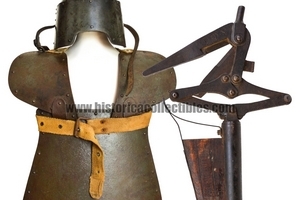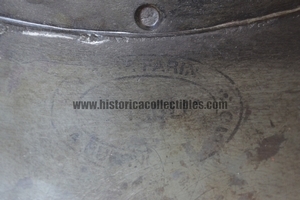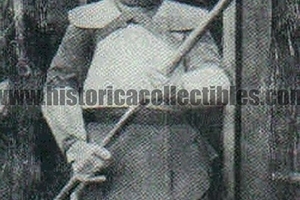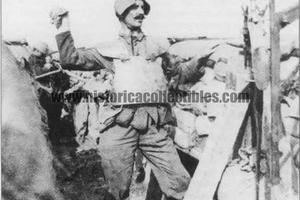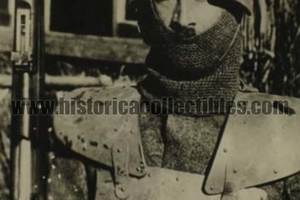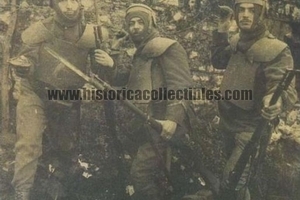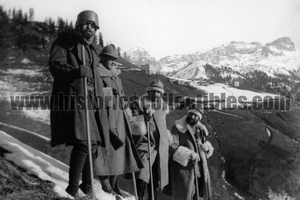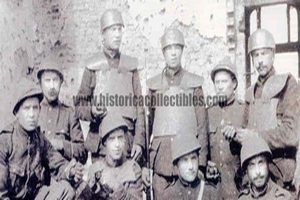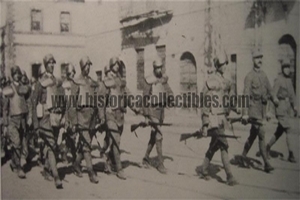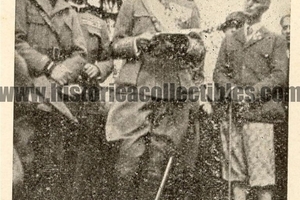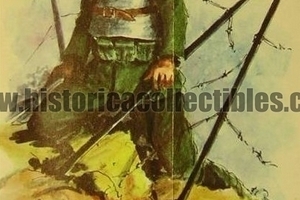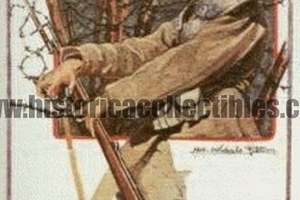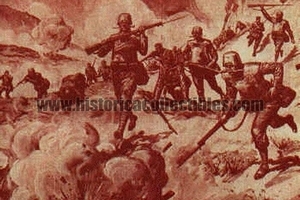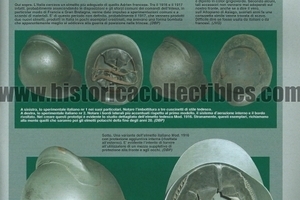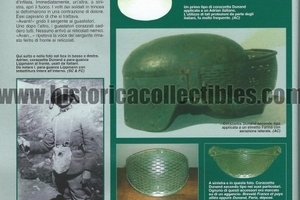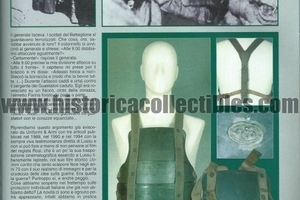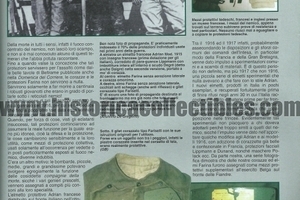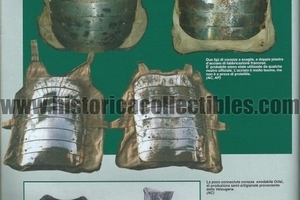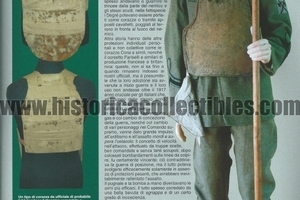Set Farina and Malfatti Pliers, Ardito "Companies of Death", circa 1916
Set consisting of Helmet and Armor mod. Eng. Farina and "Malfatti" patent wire cutting pliers supplied to an Ardito of the "Companies of Death" or "Baseggio Companies" (from the name of the Commander, Captain Cristoforo Baseggio) during the First World War. This company was made up of volunteer scouts from the 15th Division. It was made up of soldiers from all arms (Artillery, Infantry, Alpini, etc. etc.) who had the task of carrying out wide-ranging reconnaissance and incursions into the barbed wire barriers placed in front of the Austrian enemy positions. This equipement thus composed was also used by special Infantry or Engineer patrols, assigned to cutting or blasting enemy fences along the entire front.
The armor made in one size, weighing 9,250 kg, is made up of a main "pectoral" plastron measuring 30 x 40 cm made of 5 sheets of nickel-chromium steel curved towards the sides, with a total thickness of 6 mm, joined between them via 23 rivets and 2 shoulder pads, composed of 4 sheets, also strictly in nickel-chromium steel joined by 10 rivets. There are 2 metal tabs to articulate the shoulder pads.
Fixed to the external edge there are 2 straps with sliding buckles which were crossed on the back and fastened on the front. Two bracelets fixed inside allowed the armor to be held like a shield. The Farina company declared the armor resistant to perforation by the cal. 6.5 mm of the mod. 91, fired from no less than 125 meters.
The "high" or "heavy" type helmet has a weight of 2,650 kg (the original weight must have been between 2,650 Kg and 2,850 Kg depending on Size I, II or III) and is composed of a front brim of 7.5 mm thick made up of four layers of steel superimposed and held together by 5 rivets + 9 (to fix the shell and the front flap) with a height of 12 cm and the rear flap, also in sheet metal, of 4 cm high.
On the sides, near the ears, there were two rivets that held the side inserts and the leather wimple with metal buckle. Inside there is an ink stamp imprinted on the shell with the manufacturer's trademark, Ing. Ferruccio Farina - Laboratorio di via Ruffini 10 in Milan. There is also information relating to the size, which to date is not clearly visible but can be deduced, given the weight, to size I. The helmet was "guaranteed" resistant to the 6.5 mm bullet of the Italian rifle mod. 91, fired from at least 125 meters.
The wire cutters or net cutters are the "BREVETTO MALFATTI" model used by the "Companies of Death" starting from 1916. The wire was hooked and then cut by pulling the handle backwards. In the upper part there is a hook for inserting the Mod. 91 bayonet for "melee" assaults.
The pliers are the first model and are mounted on a long wooden handle on which 6 nails are still riveted which were suitable for fixing 2 "cloths" in cordura or jute to facilitate the grip (anti-slip type when tearing to sever the reticulated).
These pliers were designed to be easy to use and allow the soldier not to expose himself excessively and to be able to cut barbed wire, rounds, squares and braided rope of the largest fences, in unfavorable light and visibility conditions.
It also serves as an alpenstock; and it is a protective means for cutting electric wires, and overall constitutes an excellent defense weapon, especially for the soldier equipped with hand grenades and without a rifle.
Its blades are easily interchangeable, in the event that they become unusable.
From the original manual "Malfatti improved wire cutters - Patent of 1912 - brief theoretical - practical instruction to be given to Soldiers" taken from the book "The wire cutters of the Great War" by Simone Marzinotto, I report the following:
"The Malfatti patented wire cutting pliers could cut the fences at a certain distance, which was done by pulling the long handle of the pliers.
Malfatti designed several models depending on the type of mesh and the useful cutting distance.
1. WIRE CUTTER LANCE with long handle
2. WIRE CUTTER with short handle to be attached to the rifle and the cavalry lance
The Wire Cutter Lance is mounted on a long oil-painted wooden handle, and a special device allows you to attach the sabre-bayonet.
With it, barbed, round, square and braided wire from the largest fences can be cut easily and quickly, from near and at a distance, even without exposing oneself, in more unfavorable light and visibility conditions.
It also serves as an alpenstok; it is a protective means for cutting electric wires, and overall constitutes an excellent defense weapon, especially for the soldier equipped with hand grenades and without a rifle.
Its blades are easily interchangeable in the event that they become unusable.
It allows the Knight to quickly cut all sorts of wires hindering the march of the Squadrons across the countryside, as well as cutting telephone and telegraph wires without ever having to dismount.
How to use "MALFATTI" wire cutters:
1° Having placed the stick of the device on the wire to be cut, either from the "ground" or "standing" position, pull it slightly towards you until the wire itself, entering between the blades, offers an initial resistance;
2° Without losing contact with the wire, give a single and vigorous long pull backwards, until the cut has occurred
(in case of incomplete cutting, repeat the movement with greater vigor, taking care to first let the device return to its normal initial position by means of a slight yield."
A collection of very important historical importance.

